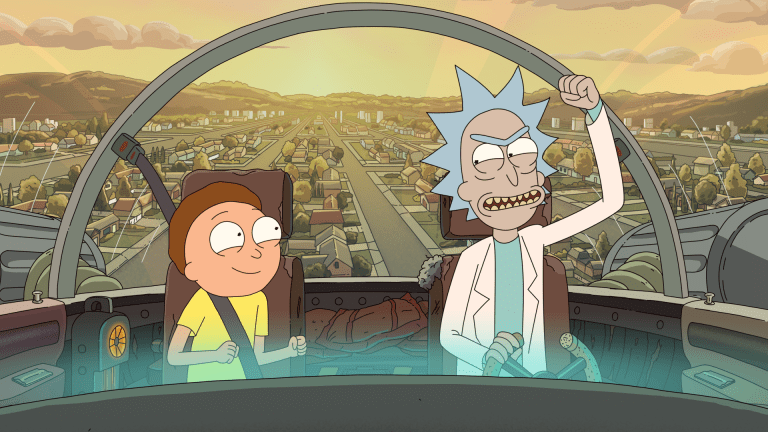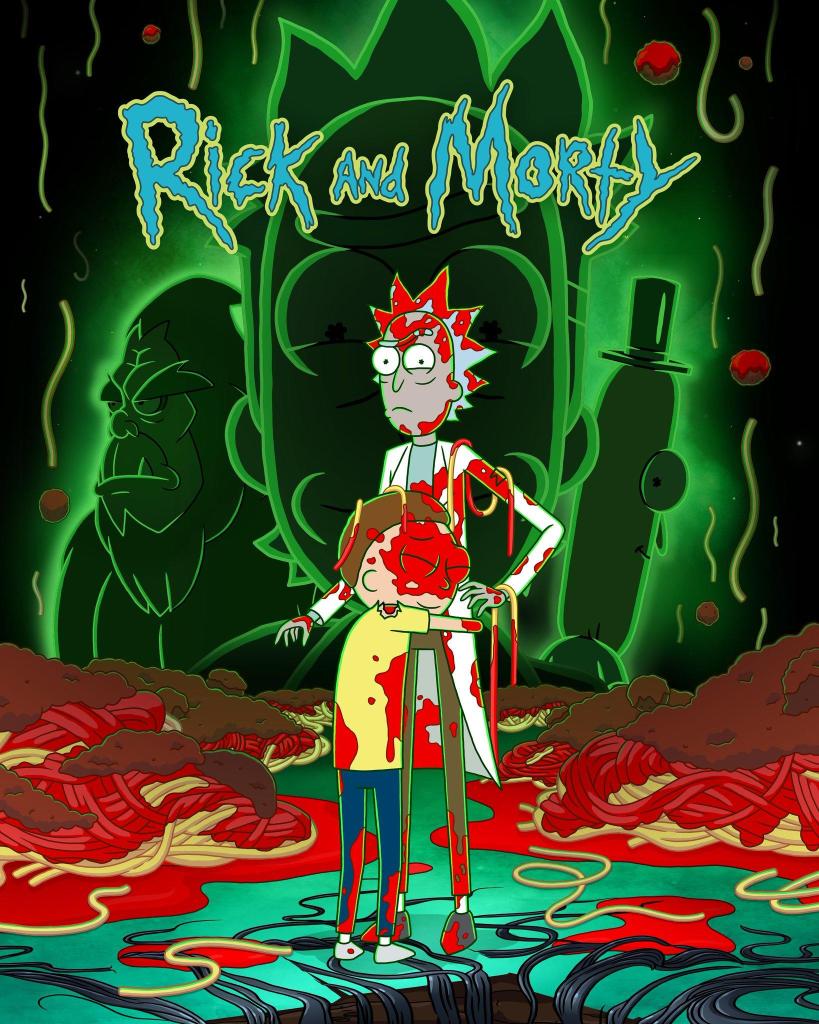Rick and Morty Faces Its Fears: Season 7 Episode 10 Explained
"Fear No Mort," the Rick and Morty season 7 finale, is a trippy experience. The folks behind it explain what it all means.

This article contains spoilers for Rick and Morty season 7 episode 10.
Rick and Morty season 7 had a lot to be afraid of.
Adult Swim‘s animated hit went into the year without the original voices of its titular characters following co-creator Justin Roiland’s dismissal of the show. This meant that the show’s writing staff, led by co-creator Dan Harmon and showrunner Scott Marder, had to work in two new major voice actors (Ian Cardoni as Rick and Harry Belden as Morty) while also fighting against the inevitable fan perception of creative inertia that all animated series face nearly a decade in.
Perhaps it’s no surprise then that the theme of season 7’s 10th and final episode all comes down to fear. Fittingly titled “Fear No Mort,” the season finale finds Rick and Morty meeting a mysterious thrill-seeker (voiced by Liev Schreiber) and being brought to a Denny’s bathroom where there exists a hole in the ground that, when entered, subjects the occupant to their greatest fear. As a helpful VHS tape (called “How to Hole”) explains, the hole operates like those little fish in Thai spas that eat the dead skin off your feet. It’s a mutually beneficial relationship: the hole gets to consume your fear and you get to conquer it. Seems simple enough – but nothing on Rick and Morty ever is.
“Fear No Mort” is very plainly an important episode for Rick and Morty. That’s evidenced not only by its status as the first post-Roiland season finale but also by the Fear Hole’s sneaky central billing on the season 7 poster this whole time (look at the bottom).

Given the episode’s importance, we were able to chat with Rick and Morty executive producers Scott Marder and Steve Levy and performers Ian Cardoni, Harry Belden, about how the whole thing came together and what it all means.
According to both Marder and Levy, much of the episode’s inception and successful execution can be credited to staff writer Heather Anne Campbell, who has written for the show since season 6 after previous stints on Whose Line Is It Anyway? and Saturday Night Live.
“One of the best all-around writers I’ve ever worked with,” Marder says of Campbell. “She taps into Rick and [Dan] Harmon. She’s got the same point of view as them in real life and her ideas come from a really dark spot. A lot of them have a Black Mirror sort of vibe to them. She felt like she had a cool standalone that helped us explore fear but also gave us a taste of a relationship that we’ve never really seen on-screen.”
The relationship Marder refers to is, of course, that between Rick Sanchez and his dearly departed wife Diane. As fans previously learned, it was the loss of Diane that set Rick down the path of both multiverse exploration and gleeful self destruction. Still, it wasn’t until the Fear Hole (Note: That’s just what we’re going to be calling it from now on. You’re gonna have to get used to it.) that the show actually had a chance to manifest Diane and delve into what made their relationship work.
“All we’ve seen of Rick’s relationship is that tiny little blip in the garage,” Marder says, referring to the moment Diane was killed. “This [episode] was kind of this whole magical fairy tale that gives Rick the opportunity to be with a loved one while still moving the story forward. [Diane] is the sort of spiritual center and spine this season. She’s the reason that Rick’s been doing everything for.”
Fabricated as it all may be by the Fear Hole, Rick and Diane go through a lot in “Fear No Mort.” We first see how this apparition of Diane reacts in horror to the nihilistic monster her husband has become. (“Stop wearing my husband’s face. You’re nothing like him,” she says. “Because I lost you!” Rick replies). But as time drags on, Rick and Diane begin to fall back in love, assisted by some alien alcohol, which naturally makes Rick want to live inside the Fear Hole forever.
If that all sounds like pretty emotionally complex stuff for any voice actor to tackle, imagine a voice actor tackling it on their first day of the job, which is essentially what Ian Cardoni had to do as the new voice of Rick.
“We initially started with the finale,” Cardoni says. “By the end of the summer [of recording], I felt I could top myself for a lot of what I had originally. So we collectively made the decision to re-record a lot of that finale so it would sync up with a lot of the work I had been doing.”
Even though “Fear No Mort” represents the first time that Diane has appeared in the flesh, albeit the Fear Hole-rendered flesh, her presence has indeed loomed large over this season. In the season 6 finale, Rick finally made the decision to track down and kill his greatest foe: Rick Prime – the man responsible for killing Diane and setting him down this dark path. In true Rick and Morty fashion, however, the culmination of that path arrives pretty quickly.
Rick finds and kills Rick Prime, not in the season 7 finale but in its otherwise unassuming fifth episode. As Marder explains it, the decision to launch the “lore-heavy” season 7 installment earlier than expected opened the season up to deal with its consequences, particularly with the finale.
“We put [episode five] there intentionally so we could enjoy getting to see how Rick is dealing with life after. What on Earth is he going to do now? That episode was about getting their groove back and we’re gradually see Rick step back into his shoes in the back half of the season and get back to his new normal.”
“Fear No Mort” is naturally filled with many twists and turns, none of which are more shocking than the twist at the very end. As it turns out, the Fear Hole isn’t generating Rick and Morty’s fearful visions but only Morty’s. The Fear Hole can accommodate only one fear at a time, which means that for once, Rick Sanchez isn’t the center of the universe.
“Heather’s pitch was that you find out it’s either Rick or Morty’s darkest fear,” Levy says. “We went back and forth [on whose fear it should be]. I don’t remember how we landed exactly the way we did. But I imagine that, given how much we already gave Rick this season, we wanted to give Morty a little more.”
In the end, the Fear Hole really does seem to work like those skin-eating fishies in Thailand as the VHS promised. It takes a hell of a lot of time (including the maturation of Morty into an actual grown adult) but Morty finally comes to terms with his biggest fear: that of being left behind by Rick.
Historically that’s been a valid concern for Morty. For, as both the characters and the show around them grow, Rick and Morty have become more independent, emotionally distinct individuals. That this all happening now, however, is just one added level of difficulty for the fresh voices portraying them. Due to the abrupt nature of the recasting, Cardoni and Belden crammed a whole season’s worth of voice work into one summer, something that likely won’t happen again in the seasons to come.
“I just thought that was how we normally did it,” Belden says. “We were doing two three-hour sessions a week and probably getting through half an episode a session. I didn’t know any other way. I was just in work mode.”
With Morty finally facing his fears, Rick flat out killing his, and the voices of each getting a year of experience under their belts, the multiversal future for Rick and Morty suddenly looks quite bright once again.
